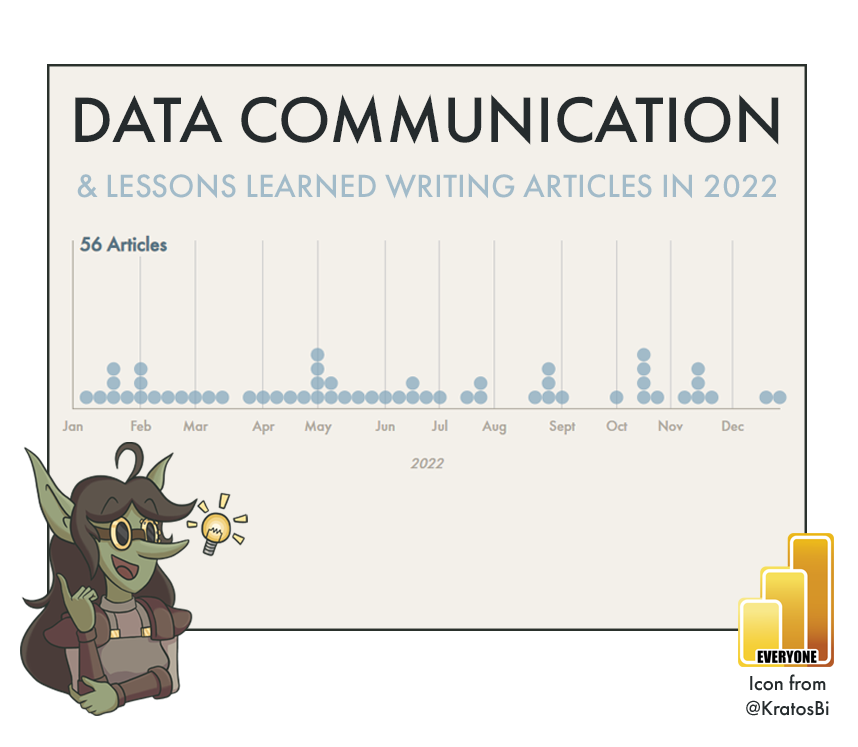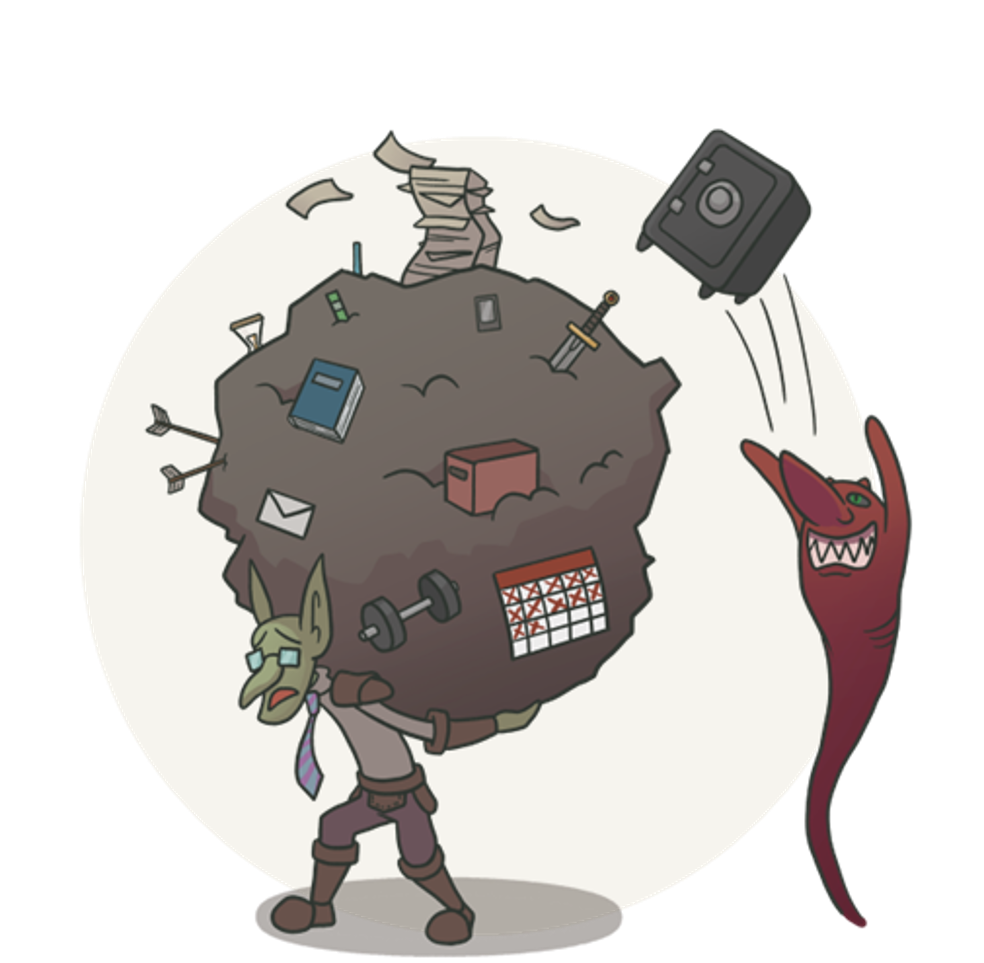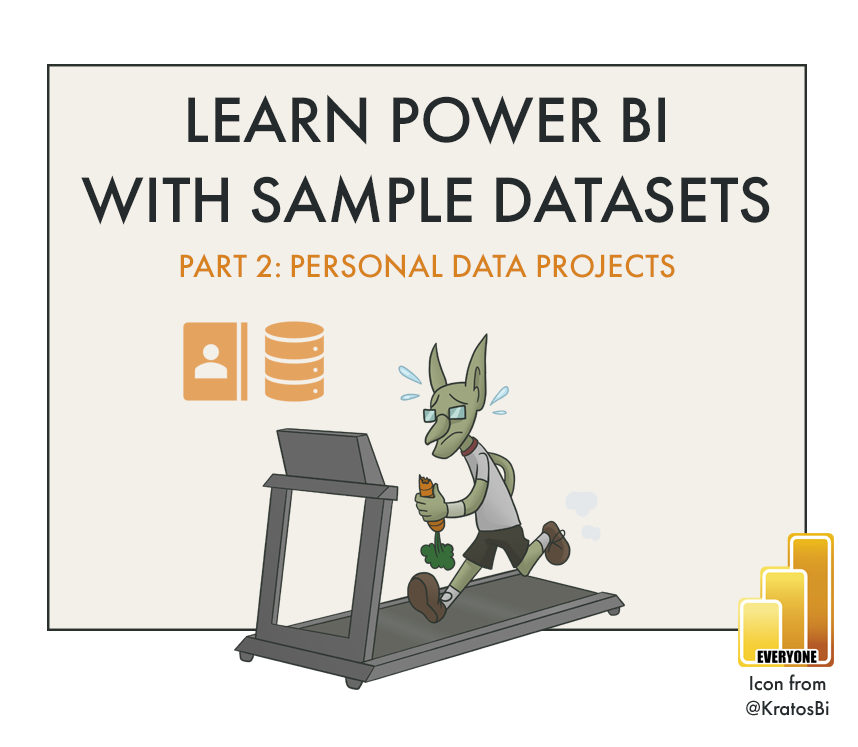Advance Your Career & Learning with Data Communication
WHY DATA COMMUNICATION IS SO VALUABLE
…and sharing what I’ve learned from my own experiences writing these articles
WHAT IS ‘DATA COMMUNICATION’?
Nothing helps you learn better than trying to explain a complex concept concisely, well and in simple words. This — in a nutshell — is why I think that data communication is one of the most valuable activities you can do to advance your learning and your career. By data communication, I refer to any activity centered on explaining data concepts to other, non-experts:
Writing articles
Speaking at conferences
Making YouTube tutorials
Actively sharing content and templates online or via social media sites.
Teaching at camps or schools … to name just a few of many examples
Participating in these or similar activities have benefits for you, your organization and your audience:
To effectively communicate a subject, you need a certain depth of knowledge. You are driven to research the topic and grow your understanding, that you can explain it to others. This exposes gaps and assumptions in your knowledge once previously hidden. You will unveil things you hadn’t previously considered, or perhaps that you had not understood it as well as you once thought. As a result, you learn more, faster.
Your knowledge gain is accelerated not only while preparing the content, but also delivering and discussing it. Participating in these activities leads you to engaging with peers and experts who have different experiences and perspectives. Talking with and listening to them will further extend your learning, helping you consider new points-of-view and more efficient ways of tackling problems you couldn’t have considered on your own. Participating in this ‘data community’ is the adhesive that connects your bricks of knowledge together, helping you construct a lasting, strong foundation upon which you can build further learning of more advanced concepts.
Lastly, over time, these data communication activities bring benefits to your career. You become known among this community and your audience, bringing new opportunities and accelerated growth.
These data communication activities benefit not only you, but also your organization. In sharing your knowledge and expertise, your organization gains exposure. This marketing establishes their innovation and support of open knowledge-sharing, which provides new opportunities and grows positive brand sentiment. Further, it helps their name become known among a ‘data community’ of experts. In a competitive labour market, this is incredibly valuable, giving organizations a new channel to recruit and hire good talent.
This is true even if you don’t explicitly seek it; if you don’t mention your employer or they don’t participate in your events. They will benefit in some capacity as you become more known and people seek you out, finding you work for the organization on LinkedIn or hearing it from you, first-hand.
The third and most obvious benefit is to the people consuming the content you create. These people can learn from your experiences and expertise to solve their problems or see something from a new perspective. Even if you help one individual, this can have far-reaching consequences to not only help them, personally, but also cascade within their team, organization and even sector.
I personally believe that putting time and effort into data communication can one of the most valuable investments one can make for their learning and career. Speaking from subjective experience: Thanks to writing these articles, I feel I’ve learned more in the last year than the previous four years, combined. In this article reflecting back over 2022, I share what I’ve learned writing articles for the past year; why I write them, how I plan them, and how long it all usually takes. The purpose of this article is to share my own experience and possibly motivate or help someone else write their own articles, in the future.
I. OBJECTIVES, KEY RESULTS & GUARD RAILS
When deciding to create content, it’s important to first ask ‘why’. Why do you want to create a blog, a YouTube channel, a presentation for a conference? What is your goal, your objective? What do you hope to get out of it? This might seem trivial, but it’s easy to already slip up, here, in setting unrealistic or vague goals and expectations. Before starting your data communication journey, I suggest spending some time reflecting upon he below:
Objectives: What do you hope to accomplish, in a general sense? Why do you want to do this?
Key Results: What concrete, measurable goal will you accomplish in a defined timeframe to ensure you accomplish the above objectives?
Guard Rails: What ‘rules’ can you set up to safeguard yourself from over-investing in these activities and having a bad experience, or getting burned out?
Below I reflect on how I defined these things for myself regarding the articles I write on Data Goblins.
OBJECTIVES: WHY WRITE THESE ARTICLES?
I started writing articles at the start of 2022. My personal objectives for Data Goblins were four-fold:
The pandemic was an isolating time. I found it difficult to find and connect with other people interested in Data / BI or Power BI. While it is easy to find such communities in social media networks, truthfully, I found it difficult to participate in them. In the past, I tried, but felt too often like a stranger looking in; that person at the party who quietly walks into a circle of friends without an invitation. The openness of the internet certainly doesn’t abolish ingroup mentalities and imposter syndrome; if anything, it amplifies it.
Over time, I learned the best way to participate in these communities is to contribute with content. I thus made a fourth objective to hopefully meet & connect with other, like-minded folks through the things I write. In truth, I had no idea how this might happen, but figured I’d just stay open-minded and welcoming for all and any feedback or discussion, even strong disagreements or criticism which could open me to some new perspectives.
My background is in Biomedical Sciences; I used to work in a research laboratory, where I had never even heard of SQL, Power BI, or even business reporting in the broadest, most general sense. Everything I learned about Power BI and Business Intelligence was self-taught from peers and experts, who share their knowledge freely in the workplace, at conferences and online. Over the years, as I became more comfortable with my knowledge and experience, I started to feel the responsibility to reciprocate this; I had taken so much from the data community, and didn’t feel like I had given much of anything back.
In December of 2021, I decided I’d start trying to write articles that might help others. Specifically, I sought to explain complicated or nuanced concepts in ways that anyone could understand. This is something I wanted to do not only because I felt I should, but because (for now) it continues to give me an intrinsic sense of personal & professional satisfaction.
In the past, I struggled to find motivation, direction and focus to dedicate to specific topics I wanted to learn. When seeking to learn something, it was difficult to define a concrete endpoint. By concentrating that energy on a single output — the article — I could more easily define topics and time slots to dedicate to learning. I thus decided that with each article, I’d seek to learn more about:
The subject I’m writing.
How to effectively communicate it from within an article.
This is something I wanted to do so that I could accelerate my learning and limit it to ‘completable’ blocks of output, which was not only healthier for me but also gave me personal satisfaction.
Over the span of time - even a single week - I found I encountered problems and challenges that recurred frequently in different contexts. It felt inefficient that it cost time for to re-explain or revisit again the solution, instead of dedicating time to explain or document it. This was particularly true for non-technical challenges, such as requirements gathering, adoption / change management, or asset handover. I decided a third objective of my articles would be to write things that were useful also to myself in the future, to refer to when explaining things to clients or colleagues.
I thought this would give me resources I controlled to save me time and help me explain things that I felt were important in my professional life.
KEY RESULTS: HOW TO REACH THESE OBJECTIVES?
The biggest obstacle to overcome in accomplishing these objectives was execution; consistently dedicating time and producing output. As a result, I defined a single key result to obtain in 2022: write 52 articles; an average of one per week. I figured in doing this, I could build the right habits and find my own style and voice over time. I wanted to keep it simple; I didn’t want to define additional success criteria to avoid putting undue pressure on myself. So long as I wrote enough articles, I was confident I’d fulfill my objectives. Article output was something I had complete control over, unlike engagement metrics such as subscribers, unique visitors or pageviews, so I felt at less risk of burning out and giving up.
Further, it was never my goal or ambition to become a Microsoft MVP or build a business from this site. In truth, I did not consider either of those things remotely possible when I started. Both did end up happening in 2022, but they remain explicitly distinct from the content I produce, at least from my intent.
Below you can see an interactive timeline visualizing when & how many articles were published in 2022:
= An article published in 2022
Click a circle to open the article
56 Articles
By the end of the year, I had met this goal, writing 56 articles. In general, I aimed to publish one per week, but didn’t bind myself to that rule, so I wouldn’t “slip” if I missed one. It was a good amount to build the habit of writing, but in hindsight 52 is too much. Looking back, I’m glad I kept my goal simple, but realize that differences between articles somewhat undermined this metric. Some articles were long and complex, taking over 16 hours to produce, while others took several hours from start-to-finish.
AN ASIDE - HOW LONG DOES IT TAKE TO WRITE AN ARTICLE?
During the year, I documented approximately how long I spent on each article. On average, an article took ~10 hours of work, including the text, images, demos, layout and editing / publication. A few articles were outliers, either because of the complexity of the subject matter (“You Can Do This, Dammit”, about mental health) or because I spent significant time learning something technical (“Run Powershell with a Python GUI”, where I spent days learning how to make graphical user interfaces with Python).
An interactive overview of how long each article took is below:
Avg
= An article published in 2022
Click a circle to open the article
To be clear, I don’t think you need to invest this much time in a blog or article to produce a quality output. The figures reflected here are a result of my own personal investment because I like what I do.
GUARD RAILS: AVOIDING BURN OUT
It’s very common for people to create initiatives and start strong, but very rapidly burn out, abandoning it after only a few weeks or months. This is something I’ve done myself, many times. To avoid this, I set up some ‘guard rail’ rules for myself before starting the blog that I’d adhere to. The purpose of these ‘guard rails’ were to avoid over-investing and pressuring myself; burning out and losing the intrinsic enjoyment of writing.
This is something extremely subjective and personal; I don’t advocate the below, just share what works for me:
I promised myself I’d only create articles so long as I enjoyed doing it. Right now, it’s something I enjoy very much, but that could very well change next year, next month, even tomorrow. If that’s the case, I’ll stop doing it. The reason I set this guard rail was to avoid losing the intrinsic enjoyment; to avoid feeling pressured into writing something.
I further didn’t want to pressure myself into writing about specific topics or areas, too early. I wanted to have the freedom to write about what I want, when I wanted to. This is something temporary that I decided so that I could explore different topics and discover what I liked writing about, and what I didn’t like writing about. Eventually, I expected that I’d end up specializing in certain topics, though I didn’t want to restrict myself prematurely in case, over time, I discovered I didn’t enjoy it.
In relation to this, I also don’t care for novelty; what has already been done by someone else. If I decide to write about something, I don’t check if it’s been done before. Usually, I write the article, noting in research any references I may wish to link after-the-fact. My personal opinion is even if something has been covered by dozens of other people, it’s no less worth discussing; each voice brings a fresh perspective that could help someone else in understanding it.
To ensure that the things I make can be trusted, I wanted to adhere to a specific quality standard and process. There are a few things that I do for this:
Never publish something the same day I start it.
I need time to review it; to sleep on it, and check the article with fresh eyes.Get someone to proofread it, if necessary.
Usually if the topic is complex or I’m not certain about something, I ask someone I trust to read it and provide feedback. Usually, the harsher the feedback, the better. I don’t tend to ask people for feedback if I know they will just say it’s good.Create my own figures & images.
I explicitly avoid including figures from online, because I find while creating my figures is when I tend to understand best the problem.Be consistent in structure, format and tone.
I try to ensure that the layout and format of the articles are similar. I think it’s okay if they are a clear evolution or iteration over the previous article, but it should not be unnecessarily different.
Every week, I try to set aside specific, predictable time to work on an article. Typically, this tends to be 06:00 - 10:00 on Saturdays & Sundays. I otherwise only work on it during blocks of ‘idle time’ on evenings or weekends, instead of browsing the internet or checking my phone.
To have a deadline, I aim for Tuesday mornings to publish. The reason is I usually finish articles on Sunday and can re-read them Monday evening for a last revision. In reality, though, many articles are written weeks before they are published, so I have more time to iterate and revise.
There’s a particular phenomenon that I’ve heard be called the “New Year’s Resolution effect” — the more you say you’re going to do something, the less likely you are to do it. For me, personally, I find this also to be true with my articles and site content. For this reason, I tend to avoid talking about articles until they are complete, particularly larger articles.
This is also a protective effect, because in talking about the articles I create the private expectation that I should “finish it soon”; it creates an invisible pressure, and inevitable disappointment as it gets pushed further down the line. To avoid this, I keep my publication schedule and plans private.
It’s easy to get caught up in the rat-race of tracking and comparing content engagement metrics. This is something that can be very damaging to mental health, causing a toxic, invisible pressure to perform. To avoid this, I do not check engagement metrics of individual posts; I only check monthly and daily aggregate figures, and keep those private. To get quantitative feedback about what content works, I find this sufficient.
For social media content announcements this is more difficult, particularly because peer comparison has become so normal. To avoid this having a negative impact, I disable notifications on all social media applications of my phone and mute my own posts, checking them only at the end of the day to respond to comments or questions. On my desktop computer, I have used a browser extension to hide the number of followers on my profiles and engagements on my posts. I personally find this helps me engage with others while avoiding the dopamine exploitation of the applications.
Lastly, I don’t really care if people imitate or copy style, content or structure of my posts / articles. Intellectual property protection is something I do using other, more explicit means, where necessary.
II. PLANNING CONTENT
“But what would I write or speak about?” Once you’ve committed to making an article, video or presentation, this is typically the very next question. A misconception is that you need to already be an expert to do this; that isn’t true. What’s just important is you pick a topic you are interested in and begin planning & researching. Doing good research will help you learn and create good content for others. You might not yet realize it, but your perspective and experiences (even if limited) are unique, and can shed new light over old darkness.
Further, it’s important to understand that you shouldn’t expect to be a master at creating this content out-the-gate. Over time, you will learn and iterate, finding what works best for you and your audience. Being constructively critical and self-aware of what works and what doesn’t is essential, and not shying away from failures or feedback so you can continue improving. In the beginning, it’s the process that’s valuable, more than the result.
Below I outline in brief how I plan my own articles:
While this may seem very structured when laid out in this nice image, these steps are largely driven by my gut-thinking and impulses; they’re habits now, more than a structured process that I follow.
III. A CONTINUOUS LEARNING EXERCISE
Once you’ve started creating content, it’s important to take time to reflect now-and-then about what you’ve learned and how you can apply it. This is true not only for the subject matter that you’re communicating about, but also the mediums & methods you’re using to communicate with. Typically, I’ve found this works best when working on the next piece of content. Simply take a moment to reflect on how you can make it better than the previous one.
Below are three things I learned this year while writing these articles. They reflect my personal opinions and experiences; they aren’t necessarily advice:
Consistency is key. I think it was my ice hockey coach who used to say that. Regardless, it’s true. Consistency in all its forms helps you create better content and grow an audience:
Consistency in when content is available
Consistency in how it’s shared
Consistency in topic & format
Consistency in style & branding
I don’t think any of this is surprising, yet it’s still difficult to do. I personally think that building the habits and discipline to produce consistent content at a consistent pace is one of the most important steps to succeeding in a data communication journey, no matter your objectives & goals.
The second most important factor is conciseness. Being concise has always been one of my biggest challenges. It still is; the hardest part of writing these articles is reducing their length; the most frequent (and fair) complaint from people reading. I’m constantly looking for ways to make content more concise & readable, and have invested a lot of time & effort in talking to others about this challenge & seeking solutions, myself.
I’ve come to realize that this is a much, much bigger issue — We really don’t realize just how totally overwhelmed everyone really is. There’s just too much information, and things are changing too fast for most people to keep up.
Of the articles I’ve written in the last year, the ones I’ve enjoyed least are those that share templates, code, solutions or patterns to be copied & applied as-is. While these kind of posts often tend to be quickest to write and seem to get a lot of sustained attention, they produce the highest volume of questions and maintenance effort after-the-fact. This might still be rare, but with each additional post there are more chances of a future question or potential issues. Since the reliability of the article hinges on the solution working for readers, it’s important to address these questions, but this always takes a significant amount of time. It’s impossible to guess what the issue might be without sufficient information and investigation, and there are many reasons why the shared solution might not work for someone vs. working on the author’s machine:
They copied it incorrectly
They are unfamiliar with the approach or technology
They are missing a dependency or are running a different version / system / locale
They missed or misunderstood a previous step & pre-requisite
A change in a dependency or the program itself broke the code or solution
etc…
Often, the people contacting about these solutions are seeking a specific solution to a specific problem for which you lack essential context. As a result, it’s difficult to help, and they can quickly grow frustrated as another ‘solution’ they found online fails to address their issue, even though it might not have ever addressed their issue in the first place. Worse, this can lead to potentially exploitative situations where the person expects free consulting or advice.
Moving forward, I decided to limit such posts heavily in scope, focusing more on explaining well the approach, methods & thought process, than providing a copy & paste solution.
The health of a community is measured — in part — by its ability to acknowledge disagreement and constructive criticism. In the age of online, text-based communication, this is becoming increasingly difficult, as disagreement is often conflated with a personal attack, and communities retreat toward closed chambers of fewer voices.
While disagreement or criticism might make us uncomfortable, they are essential ingredients for improving both our skills and our understanding. It’s important that we exercise the muscle of debate, and put effort in exposing ourselves to new information or different perspectives than the ones we know. Some of my favourite articles authored this year are a product of discussions with colleagues and peers about topics where we intensely disagreed, or where someone else presented me with a perspective I’d never considered before. The discussions that resulted helped form a better understanding of the underlying problem, and helped me better articulate my own point-of-view.
Below are three examples:
“We Need This Report in Power BI”
This article resulted from a few heavy discussions with peers about the requirements-gathering process and the nature of “changing requirements”.The Goblin Behind the Model
This article is a product of criticism I received for a rather harsh audit I gave of a data model. The resulting article was a self-reflection on how we aught to give feedback and how — in the future — I might voice criticisms to the benefit of the organization’s overall data culture & change management.Self-Service Tooling in Power BI
This article arises from various discussions about self-service and trying to articulate a structure or hierarchy to match tooling to user needs & skills.
This is true not only for subject matter, but also articles in general. Criticism and feedback about my articles have helped me iterate to find the right structure & style of writing.
TO CONCLUDE
Data communication is the act of investing time and effort in explaining data concepts, from theory to tooling, in your medium-of-choice. This can be anything from written articles to podcasts to videos and even live lectures and classes. Doing this not only helps others in growing their data skills and data literacy, but develops your own communication skills and understanding of the subject matter.
LOOKING AHEAD
In the last year I wrote 56 articles about various topics related to Power BI and being a data professional. In that time, I’ve learned a lot and greatly benefitted from this investment. Moving forward, I will be writing less articles (avg ~one per month, minimum), but hope to continue helping folks do cool stuff in Power BI.
Thanks for reading, Happy New Year & keep on keeping on.















